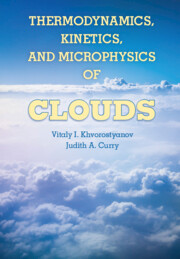Book contents
- Frontmatter
- Contents
- Preface
- 1 Introduction
- 2 Clouds and Their Properties
- 3 Thermodynamic Relations
- 4 Properties of Water and Aqueous Solutions
- 5 Diffusion and Coagulation Growth of Drops and Crystals
- 6 Wet Aerosol Processes
- 7 Activation of Cloud Condensation Nuclei into Cloud Drops
- 8 Homogeneous Nucleation
- 9 Heterogeneous Nucleation of Drops and Ice Crystals
- 10 Parameterizations of Heterogeneous Ice Nucleation
- 11. Deliquescence and Efflorescence in Atmospheric Aerosols
- 12 Terminal Velocities of Drops and Crystals
- 13 Broad Size Spectra in Clouds and the Theory of Stochastic Condensation
- 14 Analytical Solutions to the Stochastic Kinetic Equation for Precipitating Clouds
- References
- Notations
- Index
12 - Terminal Velocities of Drops and Crystals
Published online by Cambridge University Press: 05 September 2014
- Frontmatter
- Contents
- Preface
- 1 Introduction
- 2 Clouds and Their Properties
- 3 Thermodynamic Relations
- 4 Properties of Water and Aqueous Solutions
- 5 Diffusion and Coagulation Growth of Drops and Crystals
- 6 Wet Aerosol Processes
- 7 Activation of Cloud Condensation Nuclei into Cloud Drops
- 8 Homogeneous Nucleation
- 9 Heterogeneous Nucleation of Drops and Ice Crystals
- 10 Parameterizations of Heterogeneous Ice Nucleation
- 11. Deliquescence and Efflorescence in Atmospheric Aerosols
- 12 Terminal Velocities of Drops and Crystals
- 13 Broad Size Spectra in Clouds and the Theory of Stochastic Condensation
- 14 Analytical Solutions to the Stochastic Kinetic Equation for Precipitating Clouds
- References
- Notations
- Index
Summary
Review of Previous Theories and Parameterizations
Whereas a number of factors can contribute to inaccurate simulation of the gravitational fallout of cloud particles and hydrometeors (e.g., inaccuracies in parameterization of particle size distribution, habit and density), a key element in the parameterization of precipitation and gravitational settling of cloud particles and hydrometeors is the terminal velocity.
Probably the first known attempt to explain fall velocity was made by Aristotle in the 4th century B.C. Aristotle observed that heavy stones fall much faster than light leaves falling from trees and concluded that the fall velocity of a body is proportional to its weight. Aristotle did not clarify which velocity was meant: the initial velocity just after initiation of the fall, or the final constant velocity that the body can reach falling in a viscous media, which is now referred to as the terminal velocity.
Aristotle’s conclusion was not challenged for almost 2000 years. In the 16th and 17th centuries, Galileo and then Newton performed experiments with falling bodies, discovering that the gravitational acceleration g is constant and universal for all bodies. Newton discovered later the gravitational law, which expresses g via the masses of two attracting bodies and the distance between them. That is, g for various planets is proportional to the planet mass and decreases with height above the surface. However, over distances comparable to the depths of the planetary atmospheres and clouds, variations of g are small and usually can be neglected. Assuming that g = const, Galileo and Newton derived the equation for the velocity of a falling body, V = gt, that does not depend on the body’s mass without accounting for the resistance of the medium, but does depend on time t. It became clear that the fall velocities of heavy bodies measured over short times rather weakly depended on their weight, although there was some difference in the fall speeds for bodies of various shapes. This discovery of the gravitation law and universal gravitational acceleration g seemingly disproved Aristotle’s theory.
- Type
- Chapter
- Information
- Thermodynamics, Kinetics, and Microphysics of Clouds , pp. 577 - 612Publisher: Cambridge University PressPrint publication year: 2014



